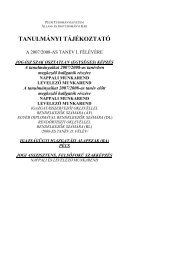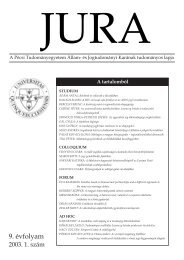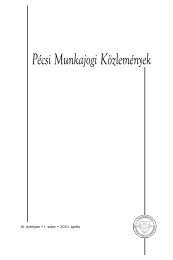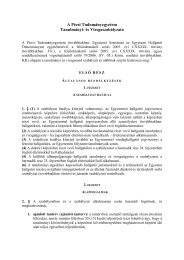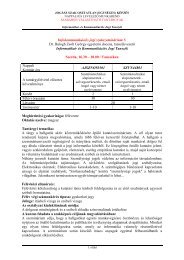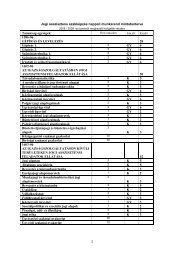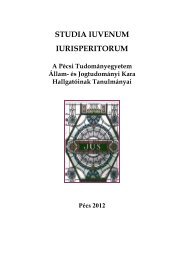2004. évi 2. szám - Jura - Pécsi Tudományegyetem
2004. évi 2. szám - Jura - Pécsi Tudományegyetem
2004. évi 2. szám - Jura - Pécsi Tudományegyetem
Create successful ePaper yourself
Turn your PDF publications into a flip-book with our unique Google optimized e-Paper software.
István Horváth: Light and shadow<br />
tion in the directive. According to the practice of the<br />
European Court, the establishment of a transfer is not<br />
affected by the fact that the operators are not owners<br />
but only lessors of the transferred assets, whether<br />
they be real estate or other assets.<br />
Apropos of this directive, I would like to mention<br />
another aspect of the harmonization tasks, namely the<br />
proceedings of the Commission examining whether<br />
the candidate member state’s laws are in line with all<br />
the provisions of the respective directives. This was<br />
a work requiring special expertise and was – for the<br />
candidate countries – a high intensity work, since a<br />
report in a form of tables of concordance had to be<br />
completed in a very short period of time!<br />
The provisions challenged by the experts of the<br />
European Commission were negotiated last summer<br />
in Brussels. We could not agree with respect to<br />
Paragraph 3 Article 4 of the directive. According to<br />
this rule, if the employment relationship is terminated<br />
because the transfer significantly changes the<br />
working conditions to the employee’s disadvantage,<br />
the employer is obliged to terminate the employment<br />
agreement or the employment relationship.<br />
According to a decision made during the adopting<br />
of the directive the said provision is implemented<br />
and separate itemized regulations are not necessary.<br />
On the one hand the legal successor is entitled to<br />
modify the employment contract only on the basis<br />
of mutual consent and the conditions of the employment<br />
can be modified only where it was the case<br />
that the predecessor had the same opportunity. On<br />
the other hand, in the case that the abovementioned<br />
general rules are violated, the employee is entitled to<br />
terminate the employment relationship by extraordinary<br />
notice and the employer has to pay the appropriate<br />
allowances relating to ordinary dismissal.<br />
For the first time the European committee monitoring<br />
the legal harmonization did not accept the arguments<br />
listed above. They gave us the following examples:<br />
where the transfer of a gazette changes the former<br />
view of the editorial office and it is not in line with<br />
the journalist’s view. The other example was where<br />
in a hospital the legal successor facilitates abortion<br />
and the doctor does not agree with it. However this<br />
legislative hardship was solved by time, as later on<br />
in autumn 2003 in Dublin the European committee<br />
155<br />
did not query the mentioned problem. Had they<br />
subsequently accepted our arguments, or had they<br />
forgotten the problem?<br />
In my opinion, recently the most sensitive question<br />
is the revision of the working time directive – and<br />
the ten new Member States may have the opportunity<br />
to influence the revision.<br />
Probably it is the inadequately precise and the<br />
unequivocal normative content of the directive which<br />
has led to different European committee and judicial<br />
interpretations relating to the most sensitive institution<br />
of labor law, the working time. Article 2 of the<br />
Council Directive 93/104/EC on the organization of<br />
working time qualifies the period of availability as<br />
working time. The definition contains two cohesive<br />
elements: the obligation of availability and the obligation<br />
of work performance. Consequently, if the employer<br />
instructs the employee to be available outside<br />
of his/her working time schedule it does not qualify<br />
as working time, it is not included in the limited 48<br />
hours. Presumably the European Committee interpreted<br />
the definition of the directive in a similar way<br />
as the interpretation of the Hungarian legislation. It<br />
can be underlined by the fact that Bruxelles did not<br />
question the „extraction” of the period of availability<br />
from the limited 48 hours. Nevertheless, two judgments<br />
of the European Court of Justice are absolutely<br />
contradictory to the aforementioned interpretation.<br />
Both cases referred to the working time of doctors.<br />
In the SIMAP-case the court – contrary to the local<br />
regulations – qualified the period of availability,<br />
which is when the doctor is on call in a health center,<br />
as working time, consequently meaning that that<br />
period should be included in the 48 hours. The other<br />
judgment refers to a German doctor – the Jager-case.<br />
The European Court of Justice qualified the period<br />
of availability as working time, with special respect<br />
to the fact that the employee is obliged to spend the<br />
period of availability at his/her place of work.<br />
The court held that the fact that during this period<br />
the employee may do anything, even rest or sleep,<br />
is irrelevant.<br />
The consequences of these two court rulings do<br />
not only effect labor law. It is mainly the finances<br />
and the number of physicians and nurses available<br />
which determines whether a member state is in a<br />
JURA 2004/<strong>2.</strong>



